Electric cargo bikes are rapidly gaining popularity both among businesses and families – and for a good reason. E-cargo bikes are said to be the future of city mobility, as they pollute less, help reduce congestion, take up less space and are just plain more enjoyable to use.
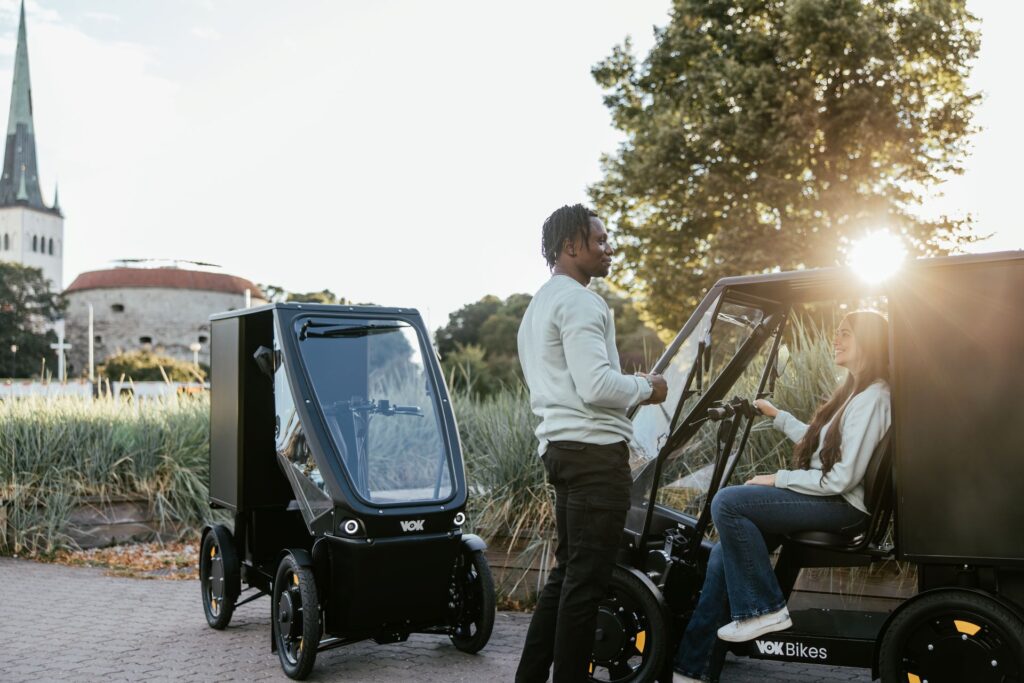
Unlike usual bikes, cargo bikes can hold an impressive amount of… well, cargo. From groceries and parcels to children and pets. Almost anything you need to move in a city for a short or middle distance, you can do with an electric cargo bike. All in all, e-cargo bikes combine the joy and flexibility of riding a bike to the capacity and comfort similar to a car.
Electric cargo bikes come in many shapes, forms and sizes, so getting to the bottom of the details and intricacies of this vehicle can seem overwhelming at first. That’s why we’ve put together this guide about all you need to know to choose an electric cargo bike for your business.
Fast forward to:
What is an electric cargo bike?
An electric cargo bike is basically an electric bike with a built-in cargo area at the front or back of the bike. The bike’s frame and drivetrain are specifically designed to handle more load than an ordinary bike. The cargo area can consist of an open or enclosed box, a flat platform or a basket. You can find a model suitable to transport anything from children, pets and groceries to business deliveries or even to use as a food cart.
Regular cargo bikes have been around for centuries and were invented in Holland, where local tradesmen used them for transporting their goods. Admittedly, claiming the honours for the idea is dubious at best since there are some forms of cargo bikes known and used all over the world, the Indian rikshaw being the most famous.

E-cargo bikes are an electric version of the classical cargo bike, making it easier to transport heavy loads, tackle hilly landscapes and drive around further and faster. They can carry loads comparable to a small car while being as compact and green as a bike.
Cargo bikes have been popular in Western Europe, especially in the Netherlands and Denmark, but they’re gaining popularity worldwide. During the pandemic biking surge, many cities from Paris to Budapest to Vilnius used the opportunity to transform their urban environments, add designated biking lanes and speed up cycling and pedestrian infrastructure development.
This opened up the opportunity to swap family cars and delivery vans for the greener – and, let’s be honest, more fun – option of the electric cargo bike. All over Europe, they’re becoming a more and more familiar sight. Many countries even offer cargo bike subsidies to promote clean mobility.
What are the benefits of using an electric cargo bike?
There are countless benefits to using an e-cargo bike – from personal, like savings and comfort, to societal, like less pollution and smoother traffic.
- Faster commuting – in comparison to cars, e-cargo bikes are actually a significantly faster option for short to middle-distance trips. In congested cities, car traffic moves notoriously slow. For example, in 2018, central London’s average traffic speed on weekdays was 11.4 km/h. For bikes, it was 15 km/h. Different studies comparing delivery vans to electric cargo bikes also show that e-cargo bikes can deliver up to 60% faster. One thing is sure, cargo bikes move through traffic more nimbly than any car could. The development of biking infrastructure can only increase this advantage.
- Cutting costs – Vok’s electric cargo bike vs. car cost comparison show’s that an e-cargo bike beats a regular van in all aspects. Firstly, an e-cargo bike is a lot cheaper to buy or rent than a car. The price per km is 10x lower than a petrol-powered car. Moreover, bikes don’t pay emissions tax or parking fees in congested city centres. Riders save time as they can find parking spaces more quickly and cut through traffic faster than cars. Combine that with lower monthly upkeep, and it’s hard not to see the benefits.
- Less congestion and pollution – electric cargo bikes take up less space, can drive on biking lanes and bypass traffic congestion. They also dramatically reduce transportation carbon footprint. Compared to a car, our Vok electric cargo bike emits 95% less CO2 over a 200K km lifetime.
- Better city environment for everyone – for all the aforementioned reasons, cargo bikes help make cities more livable for everyone. From cutting congestion and emissions to reducing the need for parking spots and extra car lanes.
- Comfort and accessibility of use – regular cargo bikes can be quite a load to pedal uphill, and cars require a driver’s licence. Electrical cargo bikes are easy to operate and can be used by people of all ages and physical abilities.
What are e-cargo bikes used for?
Business: as an electric delivery bike
Research shows that more than half of all city freight journeys could be carried out via cargo bike. Of course, an electric bike for delivery can hold 4-8 times less cargo than a van. But most vans are not fully packed all the time anyway. With the “delivery economy” soaring on all fronts, from consumer goods and groceries to the restaurant business, it could be the solution to keeping our cities livable while offering the convenience of fast, reliable and low-cost delivery.
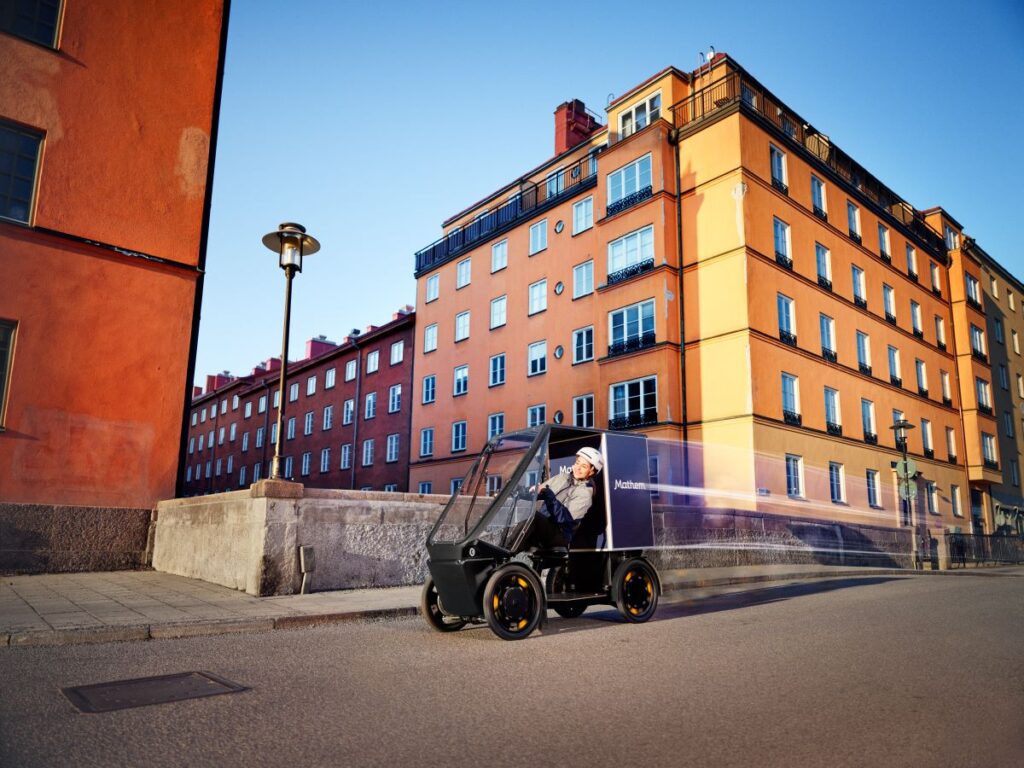
What types of businesses can use electric cargo bikes?
- Delivery services in dense urban areas – groceries, restaurants, and other goods (like Mathem in Stockholm or Wolt in Vilnius);
- Postal services (like Omniva in Tallinn);
- Food carts for ice cream, coffee, sandwiches, etc.;
- Street cleaners or recycling collectors;
- Any businesses who need to transport inventory, cargo, tools, etc. (like Tuul transporting replacement batteries to their e-scooters in Tallinn).
Family: for daily transportation
With kids or pets, having a car can seem inevitable to get around. Where else can you fit all that *stuff* that you need to lug around from day to day, not to mention on a tight family life schedule? But more and more families are finding they can carry out most of their city commutes with an electrical cargo bike. From daycare drop-offs and grocery shopping to weekend outings at the park – a cargo bike is a flexible and affordable option just big enough for daily errands and fast enough to match or surpass cars.
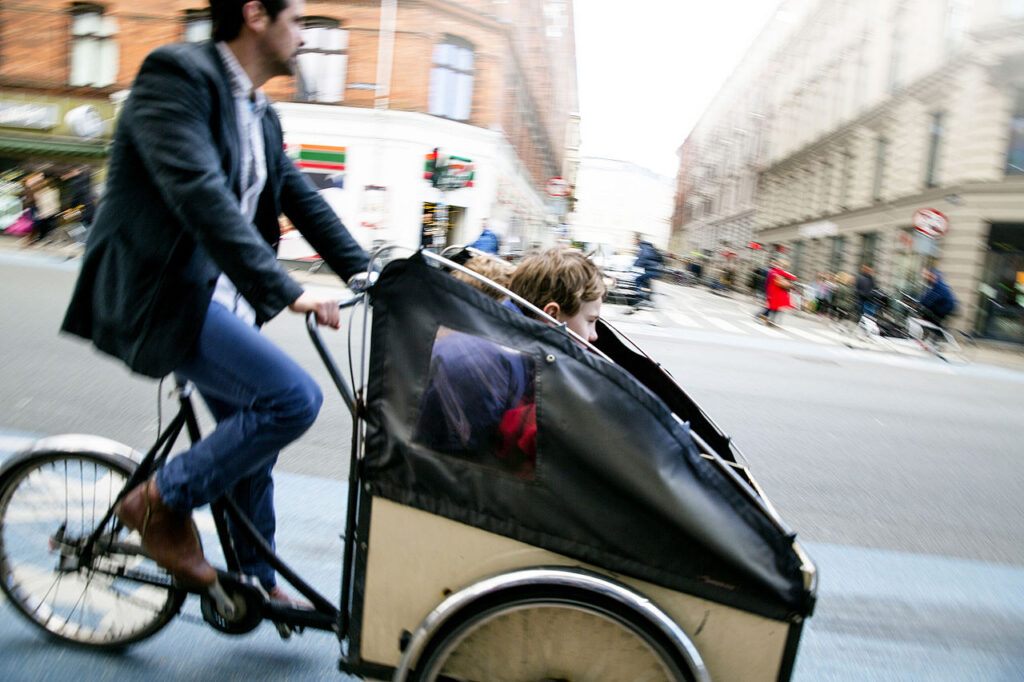
Why electric cargo bikes are a good option for family transport?
- They’re low-effort – with electric assist, you can pedal your kids to school or daycare and head to work without breaking a sweat.
- They’re safe – cargo bikes have an overall lower centre of gravity compared to a bike with a child’s seat, making them more stable. Bikes specifically designed to transport children can have collision-proof boxes, safety belts and even infant car seat adapters.
- They’re roomy – on some models, you can fit two, three or even four kids on the cargo bike, and you still have room left for groceries, packages or such.
What types of e-cargo bikes are there?
Cargo bikes, also known as ‘box bikes’, long-john bikes’ or ‘cycle trucks’ have a variety of types so you can find the right option for all purposes and preferences.
Two, three or four wheelers
E-cargo bikes have three different wheelbase types:
- Two wheels – riding a two-wheeled ecargo bike feels the most like riding a regular bike. The cargo area can be mounted both to the front and the back of the bike. Two-wheelers tend to be a bit lighter, faster and better to manoeuvre, but obviously, they’re harder to balance and thus can carry less load safely.
- Three wheels – three-wheeler ecargo bikes are more stable, wider than two-wheelers and can thus hold heavier loads. They’re also easier to load and unload, making them an especially popular option among families.
- Four wheels – four-wheelers are a more modern invention and are mostly used by businesses that need uncompromising stability and large cargo capacity. Manoeuvering a four-wheeled bike is more stable than 2- or 3-wheelers, as weight is distributed more equally, and thus it’s much more difficult to dip it over.
Body types with different loading options
With a long history all over the world, there are countless cargo bike body tapes with mild differences in frame construction, drivetrain, etc. For example, a two-wheeler cargo bike can have a frame-mounted basket or storage box in the front and look almost indistinguishable from a regular bike. When the bike’s wheels are the same size, it can be called a butcher bike, when the front wheel is smaller, it’s called a cycle truck.
When the bike’s frame wheelbase is extended to carry more passengers or cargo at the back, it can be called a mid-tail or longtail (depending on how much longer it is compared to a regular bike). Counting these variations can go on and on. All these types have their own historical or cultural background and benefits.
3 most common electrical cargo bike body types
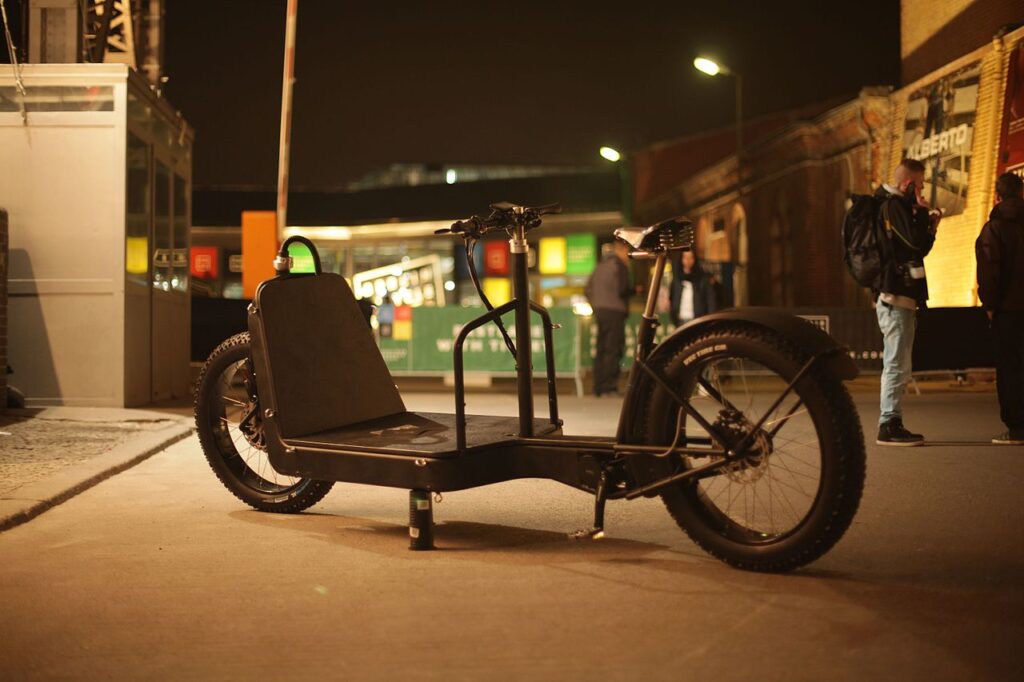
- Long John – developed in Denmark, Long John has two wheels and an extra long wheelbase at the front of the bike. The cargo area is mounted low between the rider and the first wheel. For steering, there is a linkage system between the front wheel and the handlebars, which can take some getting used to. Long Johns can carry heavy loads, but and can be relatively difficult to manoeuvre.
- Box bike (bakfiet) – this three-wheeler type is more traditional in the Netherlands and has a (usually wooden) cargo box in front. For steering, the rider has to turn the whole box, which also has its pros and cons. It’s one of the most popular types of modern family bikes.
- Rear-load tricycle or quadricycle – these are especially heavy-duty e-cargo bikes like Vok, designed to carry hundreds of kilograms of load. With the cargo compartment mounted behind the rider, steering the bike is stable and nimble.
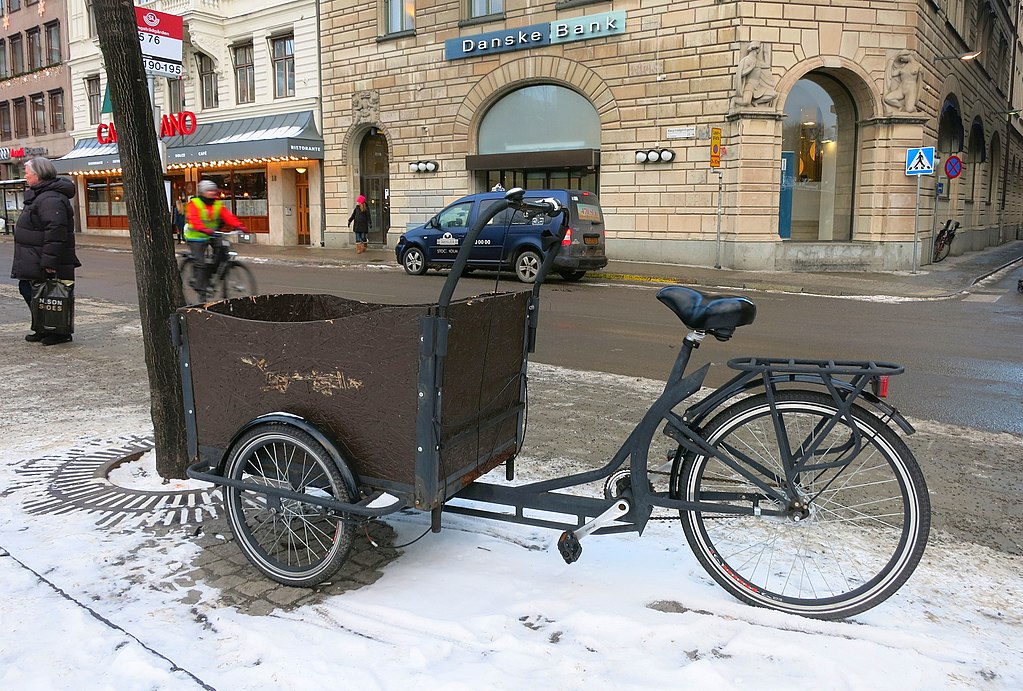
Features to look for in an electric delivery bike
When choosing ecargo bike for your delivery fleet or your business, you have requirements beyond the quality and features of a regular family bike. Here’s what to look out for.
Weather protection
There’s a big difference if you use the bike to commute once or twice a day or ride all day long. For delivery workers and other heavy-duty users, having sufficient weather protection is part of basic humane working conditions. Some cargo bikes have a roof, windscreen or even side doors to keep the rider safe from different elements. Windscreen wipers and sufficient lights are also essential to maintain visibility in difficult conditions.
Vok users like Wolt couriers have ridden the electric delivery bike through extreme northern winters and blistering heat waves. Most couriers put their bikes away for the winter, but with Vok, they maintain the flexibility of bikes with a roof over their heads. Vok also has windscreen wipers and a full light set, including low beam, high beam, indicator lights and brake lights.
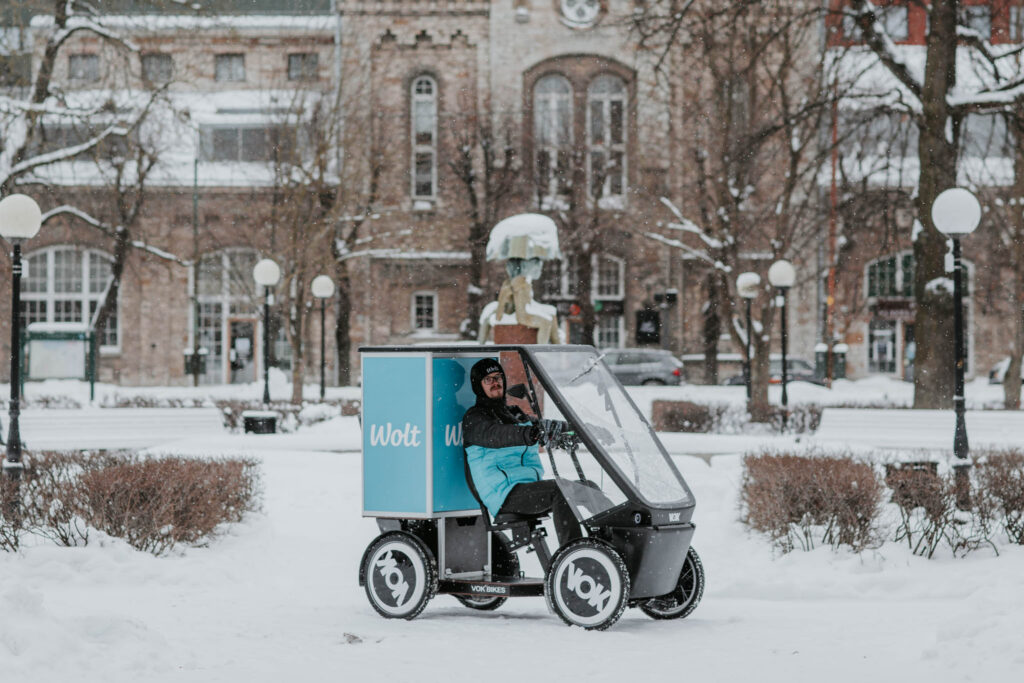
Drivetrain
The drivetrain is basically all the machinery that makes your bike move forward, traditionally consisting of pedals, chain or belt, gears, derailleur etc. The drivetrain determines how easy it is to ride the electric delivery bike and how well it handles different surfaces, ascents, heavier loads, etc. There are three main types of drivetrains used in ecargo bikes: chain, belt and chainless.
Chain
Until recently, almost all bikes used a chain. Classical chains also come with a classical derailleur that’s open to elements and physical damage. This type of drivetrain requires regular cleaning and lubricating, as well as changing the chain every 1000 km or so.
Belt
Belt drive, you’ve guessed it, uses a belt instead of a chain to pedal the bike forward. Belts are a step up from the traditional chain since they last longer, handle more strain and offer a smoother pedalling experience. They’re also silent and require less maintenance with no lubrication. Belts don’t work with the traditional derailleurs, so most belt-drive e-cargo bikes use internal gears. With internal gears, you can shift gears from a standstill position, making riding in the city easier and smoother. Also, the drivetrain is more shielded from the outside environment and more durable.
Chainless
The chainless drivetrain, also known as ‘pedal-by-wire’, ‘ride-by-wire’ or ‘bike-by-wire’ is an innovative electronic pedalling system that promises to change the world of electric delivery bikes. Basically, there is no chain or belt, but the pedalling force is transferred to electrical energy, and the signal is given to the motor to propel the cargo bike accordingly. This means there are far fewer moving parts compared to regular drivetrains, which means the smoothest riding experience, less maintenance and a very long lifetime, especially compared to chain-driven cargo bikes. The Vok bike drivetrain lasts at least 100x the regular chain’s lifetime.
Safety
Safety requirements for driving around children or driving around cargo are understandably different. But when you’re hauling heavy loads or making countless short stops throughout the day, you should pay especially close attention to brake performance and locking/unlocking speed. Here are the main safety features to look for.
Brakes
There are almost as many types of bike brakes as there are types of cargo bikes. With heavy cargo, the brakes need to do extra work to bring you and the cargo to a stop safely when and where you need to. The most common type for cargo e-bikes is disc brakes – powerful and reliable brakes that can handle any weather conditions (especially wet weather). Disc brakes also come in two most common types – mechanical and hydraulic. Hydraulic brakes have superior braking power and control, and lifetime.
Some e-bikes also use regenerative braking for a super-long driving range. Regenerative braking captures kinetic energy and transfers it into the ecargo bike’s battery. What it means is that braking helps charge the battery and wastes less energy than friction braking. Regenerative braking helps save the battery and increase the driving range of the electric delivery bike.
Vok Bike’s hydraulic braking system is custom developed based on motorcycle brake design with heavy cargo loads and ease of maintenance in mind. It combines strong braking power, low maintenance, and an extra-long lifetime compared to off-the-shelf products. Riders stay in control of the vehicle in all weather conditions with the help of traction control and e-ABS. Vok bikes also have regenerative braking that increases driving range and drastically reduces brake pad wear. You can activate regenerative braking both with a lever and by pedalling backwards.
Theft protection
Regular bike locks, e.g. chains, are a common choice for locking cargo bikes. However, locking and unlocking regular locks is disproportionately time-consuming when making many short stops and offers subpar protection against professional thieves. You should consider advanced locking options and instaling some sort of GPS or another type of tracking device in your expensive vehicle.
Locking and unlocking a Vok bike only takes a swipe with the RFID keycard. Without the keycard, you can’t ride the bike (you can push it, but can’t ride it). All Voks are also fully trackable via IoT, and the bike won’t work at all if the IoT device is removed.
Batteries and range
Electric delivery bikes often travel long distances all day long. The battery life must put up with extended use, or the batteries have to be easily swappable (with an appropriate number of loaded batteries in reserve). Also, keep in mind that heavier loads, more stops or ascents and cold weather can cut the driving range significantly.
Most modern e-cargo bikes have lithium-ion batteries that are light, efficient and with a long lifespan. The key factors in choosing an electric delivery bike are the battery’s structure and capacity. The batteries can be integrated or removable – an integrated battery means that the vehicle must stay put for charging for extended periods of time.
Vok has swappable batteries with internal heating, which means better performance in cold weather. As mentioned before, Vok also has regenerative braking, which benefits battery life and driving range. All things taken into account, this translates into an average 25% higher range compared to competitive vehicles – 100 km on a single charge with two batteries. For extra heavy-duty, Vok also has a designated compartment to store a spare battery.
Cargo box placement
Cargo box placement is important in terms of the centre of gravity, weight distribution and ease of loading. There is no right or wrong answer to whether it’s best to have the box in the front or in the back of the ecargo bike, but it’s a sum of different factors, e.g. the wheelbase and bike’s body type, rider’s range of vision, etc.
Two-wheelers with the cargo box on one end (e.g. longtails with a cargo area in the back) are obviously less stable and can handle less weight than three-wheelers with a low-set box. The front-mounted cargo box can be stable and easy to load but can fit only so much cargo until it starts blocking the rider’s view. Vok Bikes’s centre of gravity is low, the bike has optimal longitudinal weight distribution, and the cargo compartment is fully accessible from the back of the bike.
Width
If you want to ride the cargo bike on the bike lane or fit through obstacles, the bike has to have certain dimensions. Vok Bike has a bike-lane fit of 85 cm in width. That’s not much wider than a regular bike and is similar to the width of double baby strollers – just enough to manoeuvre through city streets unobstructed.
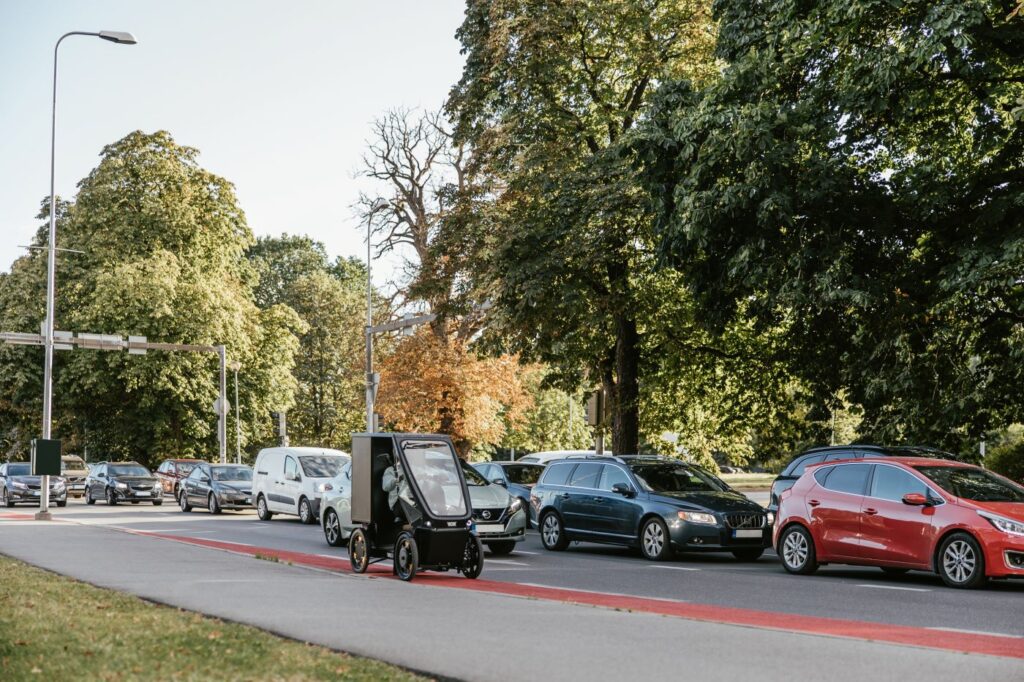
Frequently Asked Questions
How fast can electric cargo bikes go?
Electric delivery bikes could probably go faster than that, but all electric bikes have speed limits when operated by the motor. In the UK, Europe and Australia, it’s about 25 km/h, in the US, it’s 20 miles per hour (about 32 km/h).
How far can electric cargo bikes go?
The range of electric delivery bikes depends on their loads, the number of stops, the landscape and weather temperature or even the braking system. Heavy loads, many ascents and cold weather can cut the driving range significantly. Voks have a driving range of 50 or 100 km on a single charge, depending if it has one or two batteries. This range is about 25% higher compared to competitive vehicles.
How much do e-cargo bikes cost?
Electric cargo bike prices can range from as low as € 2000 to as high as € 16000. Vok bike price starts from € 8990 + VAT or € 399 + VAT monthly rental.
How much cargo can electric delivery bikes carry?
This depends on the body type and frame of the bike, cargo box placement, and many more factors. Vok has a cargo volume of 400 litres, carrying a maximum of 120 kg. Some bike models can carry up to 250 kg of load, which can be tricky to manoeuvre, though.
Is an electric bike eco-friendly?
Compared to a car’s production, maintenance and operation, cargo bikes’ CO2 emissions per kilometre are drastically lower. Vok electric cargo bike emits 95% less CO2 over a 200 km lifetime than a car. On top of that, all old Voks are disassembled and recycled back into the production of new bikes.